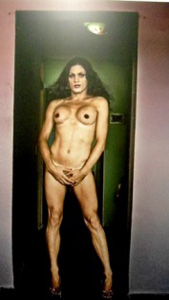A Visit to Havana’s Fabrica de Arte
Nonardo Perea
 HAVANA TIMES — I had heard people talk about Havana’s Fabrica de Arte Cubano (FAC), a place where people can enjoy different art forms such as performance arts, theater, photography, installations, video-art, films and live concerts.
HAVANA TIMES — I had heard people talk about Havana’s Fabrica de Arte Cubano (FAC), a place where people can enjoy different art forms such as performance arts, theater, photography, installations, video-art, films and live concerts.
The sheer variety of art on display there sets it apart from other venues, which do not promote culture this way.
The FAC, however, isn’t designed exclusively to expose us to art in all its different dimensions. It is also designed to make visitors consume. This is something I noticed the very moment I set foot in the place, paid the 2 Cuban Convertible Peso (CUC) cover and received a very original tab card, which reproduces the ration booklets all Cuban have.

Everything is chic and pretty. I thought it funny that they make a point of announcing that ordering food or drinks is not obligatory, as it is difficult not to do so in a place that opens at 8 at night and closes at 2 or 4 in the morning, offering a wide array of cultural activities.
Only a small area was fitted with air conditioning and one could barely notice the difference. The heat forces you to drink something, at least some water. A small bottle of the precious liquid costs 1 CUC, or 25 Cuban pesos.
But it is best not to talk about prices. We all know that prices at Cuba’s places of entertainment are high and have no relation to what the average worker earns.
I couldn’t stop thinking about losing the blessed tab card and having to pay 30 CUC for it.
I searched for other alternatives that would be less detrimental to visitors, like having the bar attendants mark a person’s wrist with a ball-point pen every time they make a purchase (if a beer costs, say, 3 CUC, they could write a 3 on the wrist). It would be difficult for someone at the FAC to lose an arm (the atmosphere is nice here, in contrast to a place like La Tropical). The second advantage is that no one would then have to worry about the ration card or spend any time worrying that it could get lost. What would happen if someone lost the card and didn’t have the money to pay for it? Worrying about that can be quite stressful.

With the card safely tucked away in my daypack, casting it the occasional glance, I enjoyed the photos of a highly sensitive and erotic exhibition (despite the fact that some of the people in the portraits had a marginal air to them). We know these people exist, but the Italian artist who photographed them didn’t identify them, for some reason. I don’t mean to say these people are inherently marginal – I only mean to say that transvestites, transsexuals and anyone who chooses to dress differently and strays a tiny bit from what is established in terms of sexuality (and one could include Emos and rock enthusiasts here) invariably swells the list of those who are marginalized, be it by society or the State. Each of the stills reveals a story. Some show us sadness, others the desire to be a woman of those who are irremediably trapped in male bodies.
The scars that breast implants leave behind are curious, as are the men who have ceased being men and began being something different.
I focused on the reactions of some visitors. Some laughed at the images, others gawked at them and asked themselves: “are they or are they not women?”
The truth of the matter is that exhibitions like these will always be welcome, particularly when they help change the mindsets of some people who are incapable of accepting the diversity of human beings.





